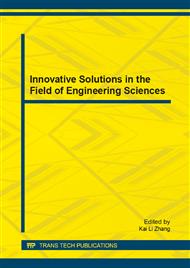[1]
Price, P.R., Geomagnetically induced current effects on transformer's[J]. Ieee Transactions on Power Delivery, 2002, 17(4): 1002-1008.
DOI: 10.1109/tpwrd.2002.803710
Google Scholar
[2]
Borucki, S., Diagnosis of Technical Condition of Power Transformers Based on the Analysis of Vibroacoustic Signals Measured in Transient Operating Conditions[J]. Ieee Transactions on Power Delivery, 2012, 27(2): 670-676.
DOI: 10.1109/tpwrd.2012.2185955
Google Scholar
[3]
Borucki, S., A. Cichon, T. Boczar, Application of Continuous Wavelet Transform to Analysis of the Vibration Signals Measurement with Modified Vibroacoustic Method[J]. Przeglad Elektrotechniczny, 2012, 88(11B): 199-202.
Google Scholar
[4]
He, J.L., Z.Q. Yu, R. Zeng, B. Zhang, Vibration and Audible Noise Characteristics of AC Transformer Caused by HVDC System Under Monopole Operation[J]. Ieee Transactions on Power Delivery, 2012, 27(4): 1835-1842.
DOI: 10.1109/tpwrd.2012.2205409
Google Scholar
[5]
Garcia, B., J.C. Burgos, A.M. Alonso, Transformer tank vibration modeling as a method of detecting winding deformations - Part I: Theoretical foundation[J]. Ieee Transactions on Power Delivery, 2006, 21(1): 157-163.
DOI: 10.1109/tpwrd.2005.852280
Google Scholar
[6]
Li, Q.M., T. Zhao, L. Zhang, J. Lou, Mechanical Fault Diagnostics of Onload Tap Changer Within Power Transformers Based on Hidden Markov Model[J]. Ieee Transactions on Power Delivery, 2012, 27(2): 596-601.
DOI: 10.1109/tpwrd.2011.2175454
Google Scholar
[7]
Ji, S.C., L.Y. Zhu, Y.M. Li, Study on transformer tank vibration characteristics in the field and its application[J]. Przeglad Elektrotechniczny, 2011, 87(2): 205-211.
Google Scholar
[8]
Huang, W., B. Wang, S. Cao, Y. Sun, L. Weng, H. Chen, Dynamic strain model with eddy current effects for giant magnetostrictive transducer[J]. IEEE Transactions on Magnetics, 2007, 43(4): 1381-1384.
DOI: 10.1109/tmag.2006.891033
Google Scholar
[9]
Sablik, M., A model for asymmetry in magnetic property behavior under tensile and compressive stress in steel[J]. IEEE Transactions on Magnetics, 1997, 33(5): 3958-3960.
DOI: 10.1109/20.619628
Google Scholar
[10]
Jiles, D.C., J. Thoelke, M. Devine, Numerical determination of hysteresis parameters for the modeling of magnetic properties using the theory of ferromagnetic hysteresis[J]. IEEE Transactions on Magnetics, 1992, 28(1): 27-35.
DOI: 10.1109/20.119813
Google Scholar
[11]
Calkins, F.T., R.C. Smith, A.B. Flatau, Energy-based hysteresis model for magnetostrictive transducers[J]. IEEE Transactions on Magnetics, 2000, 36(2): 429-439.
DOI: 10.1109/20.825804
Google Scholar
[12]
Yang Yongming, Duan Xu, Development and Application of On-line Monitoring Device of Transformer Vibration[J]. TELKOMNIKA, 2013, 11(8): 4721-4728.
DOI: 10.11591/telkomnika.v11i8.3131
Google Scholar


